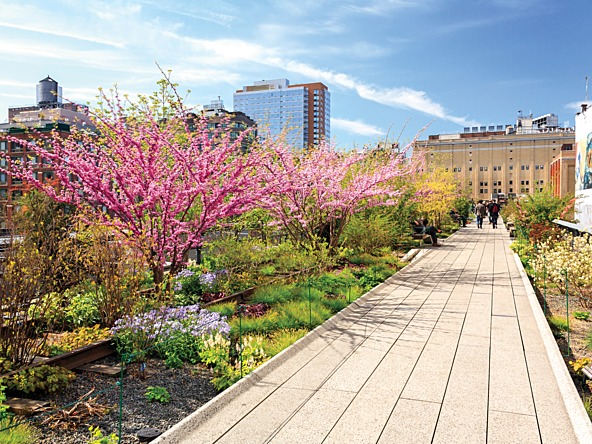Street smart: Using sensory data to improve city mapping

Urban living can have its pitfalls – noise, congestion, crowds and big commutes – all resulting in annoyed and exasperated city dwellers. While city mapping has helped with route planning, the focus of these apps is invariably efficiency – getting from A to B in the quickest time possible.
Now scientists have joined forces to rethink this type of mapping, and instead of focusing on time-saving, have considered journeys in terms of pleasure and wellbeing.
Luca Maria Aiello, a social media and computational social scientist at Nokia Bell Labs, is one of them, and has collaborated with Daniele Quercia and Rossano Schifanella to work on their project, goodcitylife.org.
“This work started back in 2014 when the three of us were working at Yahoo Barcelona. Daniele was initially working in the computational urbanism area and Rossano and I were working more in social media mining,” explains Aiello. “We wanted to provide some tools that not only maximise efficiency but also maximise the happiness of people walking around the city. It was a natural fusion between our expertise.”
By using science to help understand how people perceive their urban environment, they hope to improve that environment. “We can’t just focus on the technology without thinking about the people who might benefit. We use computational tools that look at the actual needs of people in their daily lives. Social psychologists and urban scientists say it’s mostly about capturing multi-sensory perception of people living in cities so that you can then do interventions to improve things,” he explains.
The team has built a number of maps using social media data to track sensorial and emotional aspects to cities – including ‘happy maps’, ‘smelly maps’ and ‘chatty maps’.
For instance, happy maps have been created using a crowdsourcing platform and geo-tagged pictures. By using a web game, players were asked to choose between two pictures taken in the city and say which made them happier. Based on the selections, the researchers could determine which urban scenes make people happy. The result was a routing algorithm that suggests a path that is the shortest possible while maximising emotional gain. People are literally re-routed to happier streets.
consensus was easily achieved
Quercia did the initial work with a crowdsourcing platform called urbanopticon, where people could vote on the beauty of two images. This was the initial training set for the machine-learning algorithm that learns what elements in these pictures are associated with beauty. “You can reuse these algorithms to judge any other picture, with tags attached, on beauty. This methodology can be used in principle to label every single picture in Flickr, Instagram and so on. So you can acquire the scale by looking at social media,” explains Aiello.
So would this mapping have even been possible without social media?
“At the time, we were working closely with the people at Flickr because it’s a Yahoo property. So we had access to a large number of images and data from the platform,” says Aiello. But, he adds, other data sources may have worked. “If you think about Google Street View or other mapping initiatives such as OpenStreetMap, where you have either text or tags or actual images, you could use algorithms that look at the actual image and relate the components of the image to how much the street is quiet or happy. Social media is very rich, but it’s not the only source of data for these type of studies.”
What’s interesting about this data collection is how even though something like beauty or aroma might appear to be highly personal, consensus was easily achieved.
“These are very fuzzy concepts; however, while they may be subjective, they aren’t completely random. If you ask 1,000 people to look at pairs of urban landscapes and judge which one is the most beautiful, very often you get a large convergence to one,” he says. “If you collect enough crowdsourcing data, you can make sense of what elements, on average, are perceived by the general population as more beautiful. In urban landscapes, the most beautiful are parks and greenery and the ugly things are usually very busy roads and ugly buildings.”
Within an urban context, smell and noise are usually considered in a negative light, whereas the researchers were looking for data reflecting a positive presence.
On their ‘smelly map’, the team collaborated with artist and designer Kate McLean, who has studied smells in the city. She conducts ‘smell walks’, where groups of people go round the city annotating smells. From this methodology Aiello and his colleagues could gather text smell descriptors. “We matched these tags with geo referenced tags from social media – and did the same thing for sound,” adds Aiello.
moving onto touch
Although smell could change considerably throughout the day, the maps are not adapted in that way. “If you spray a perfume on your wrist you have an initial smell and then a base note remains. So what we are capturing is the base note of the city. We haven’t done any work capturing specific smells occurring transiently.”
So far the team has mapped 12 cities – mostly in Europe and the US – as a showcase, but in theory it could be replicated for any city with enough coverage.
So what are the applications? Aiello cites two: using the routing algorithm to augment something like Google maps to give route options to maximise the happiness of your journey; and as a tool for policy-makers and city councillors to make improvements.
“There are very strong associations between type of smell and sound and the emotions that people express in the areas where these smells and sound occur. So you can use the smell-scape and sound-scape to also estimate how well people are feeling in that area.
“Policy-makers could look at these insights to make policy interventions. Of course it’s hard to measure how the impact improves people’s lives, because this is much longer term, but this would be the vision,” he explains.
And the next stage for their research is that missing sense – touch.
“Now we’re trying to finish all the sensory spectrum, and soon we’ll have something on touch. We’re working also on intangible properties such as the perception of ambience in a neighbourhood and we’ll have a paper out soon on this.
“The final thing would be to have a description of several different layers and to synthesise all these layers in one very effective descriptor and say this is a good area and this is a bad area and how can we improve the bad area.”

We hope you enjoyed this article.
Research Live is published by MRS.
The Market Research Society (MRS) exists to promote and protect the research sector, showcasing how research delivers impact for businesses and government.
Members of MRS enjoy many benefits including tailoured policy guidance, discounts on training and conferences, and access to member-only content.
For example, there's an archive of winning case studies from over a decade of MRS Awards.
Find out more about the benefits of joining MRS here.













0 Comments